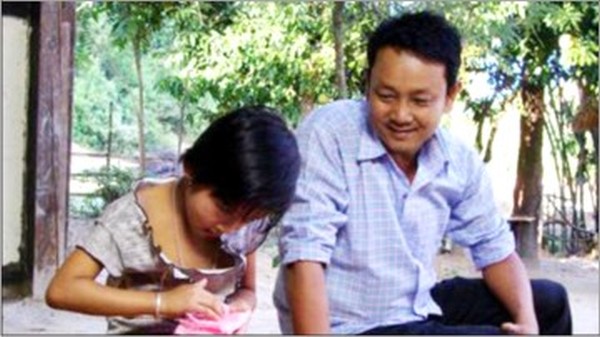Leipaklei at the Indian Habitat Centre
Kumam Davidson *

A scene from the film 'Leipaklei' :: Pix - Manipur Info Centre
Aribam Shyam Sharma's Leipaklei won many hearts at the Indian Habitat Centre in the capital over the weekend. The film based on Arambam Samarendra's Sahitya Academy award winning play of the same title finally reached Delhi after making a tour to Jeonju International Film Festival 2012, 18th Kolkata International Film Festival and 5th Guwahati Film Festival.
The national award winning from Shyam Sharma's oeuvre has fascinated viewers both from the state and outside. And most of the viewers fell in love with the realistic and simplistic though difficult craft of the film. They also expressed the idea that the film departs from the conventionally highly glamorised and stylised films that have been coming out from the Manipur digital film industry in a decade or so. In that sense it is another achievement in Shyam Sharma's career but not to say that this is the best. One always remembers a classic like Imagi Ningthem that won not just national but international recognition at a time when cinema was just a new realisation in the state.
There have been large chunks of films coming out from the industry since its inception. And one of the anxieties that both filmmakers (few) and critical viewers often share is the lack of a certain kind of representational sensibility; Meitei sensibility to be precise. This is a very complicated idea to be put forth in simple words though. Songs sequences, dances, elaborate costumes, background music together make a film.
And somewhere a certain sense of sync among all these and the context constitute a sensible representation. These elements cannot be so alien to each other so much so that the overall representation is bizzare. So the conclusion is Leipaklei somehow has been crafted with careful handling of all these aspects of filmmaking.
Of course one definitely expects such maturity from a veteran maker of films like Shyam Sharma. And few films have reached such benchmarks before. Mami Sami is also a classic now and films like Chatledo Eidi, Madhavi are exceptionals. There are more that can be put in the list. But the idea is that these few films share the reputation of having achieved the kind onscreen sensibility without unnecessary glossed overs and stylisations. One is not necessary against glamour and style per se just that necessity has to decide it.
One significant aspect of the film is also its refusal to use very mainstream Bollywood kind of song sequels that often go against the rhythm of one' s own way of life. For instance a short meitei folksong captures the female protagonist's longing for love and reunion. So the film seem to suggest the idea that one can always find expression and meaning in one's own language and tradition. And that seems to be one of the most important tasks of art today not just in the case of our industry but generally otherwise.
One can interpret that the film is performing this task too. In a way it can be read as a commentary about filmmaking in Manipur, It is trying to (re) create some of the basic ingredients of filmmaking in the industry and not to say that it is proposing just one model of filmmaking. I think there are some basic aspects that cannot be just overlooked in the name of glamour, style and globalisation.
There has to be change but not superficiality and alienation so to say. One can ask why in the first place a veteran maker of films takes up the task of adapting a classic drama into a film in 2013 especially when there is both a race for local rap music albums and a resurgence of ethnic videos even though glossed over and fortunately some well made films?
Apart from the perks the movie has gathered so far for itself one can critically think about the title and the character too. It is obvious that the title which is the name of a flower suggests courage and endurance in times of adversity. So through the course of the film the character goes through adversities because her husband has abandoned her and she is left to herself with her daughter. All is fine until one starts looking from a gender perspective.
After the screening a slightly perturbed lady even asked the assistant director of the film on the idea of the male figure designated to protect the weaker female sex the film partly endorses. The assistant concludes by saying that the story is dated in the 1960's and end of discussion. But what viewers seem to have carried back with themselves on their way back was their confusion about this slightly dismissive reply on the gender perspective.
One of the questions can be why cannot the film itself be a little more reflexive about it? And when the centrality of the story is on the notion of a figure epitomised as Leipaklei. Does the character even endorses her own epitomisation?
